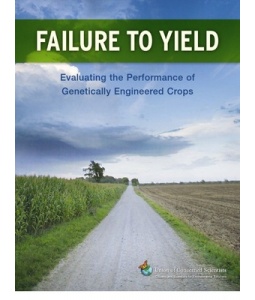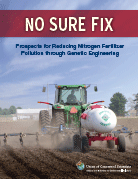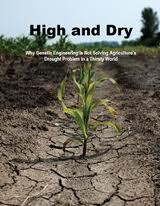I was recently a participant in a virtual forum sponsored by the Boston Review magazine called, rather grandly, “The Truth About GMOs.” I was one of eight respondents asked to provide short comments on an article by Dr. Pamela Ronald advocating greater acceptance of genetic engineering. The forum also gave Dr. Ronald space to reply to the respondents’ comments.
While the forum could have been more comprehensive in its selection of respondents, it provided an interesting and timely array of views.
Against that background, I was very disappointed that Dr. Ronald replied to my comment with gratuitous attacks on UCS and an unprofessional dismissal of three groundbreaking reports produced by my colleague, Dr. Doug Gurian-Sherman, as “widely discredited.” This remark, which is wholly untrue, originally appeared without even explanation or citations to back it up.
The unfair characterization of Doug’s reports has now been removed from the online version of the Boston Review Magazine forum. In its place are two paragraphs of specific criticisms of one of the reports, Failure to Yield. Those criticisms are primarily complaints about what was not in the report, for example, studies from the developing world—rather than scientific criticisms of methods or findings. Strangely, although they were covered in both her original and revised characterizations, Dr. Ronald provides no discussion, much less criticism, of the other two reports.
Doug has ably responded to Dr. Ronald’s specific criticisms elsewhere in comments on the forum.
Here I would like to reiterate why these reports, whose findings have stood the test of time, are so important.
Failure to Yield
Failure to Yield (2009) presented a detailed analysis of the studies, done primarily by land grant university scientists, comparing yields of GE versions of corn and soybean and their closely matched non-GE counterparts. The availability of closely matched, non-GE varieties of crops allowed scientists to tease out the contribution of the GE traits from other contributors to yield performance.
That was important because, before Failure To Yield, the possibility that anything other than GE could contribute to yield was rarely discussed. It was easy to think that all of the 1 to 2% yearly yield increases observed in corn and soybeans were the result of the introduction of biotechnology crops. The question was whether that was true…and report found it wasn’t.
The analysis presented in Failure to Yield differentiated between intrinsic and operational yield. Intrinsic yield is the yield under the best possible conditions–good soil, good weather and no pests—and is the bedrock of gains in agricultural productivity. Operational yield, also very important, refers to increases in the presence of stress. Pest resistance, for example, can enable a farmer to harvest more when insects threaten, but the yield is bounded at the upper end by the intrinsic characteristics of the crop.
The studies showed that the predominant GE traits found in corn and soybeans—herbicide tolerance and BT toxin—did not contribute to annual increases in intrinsic yield observed in corn, but–and here’s the important part—increases in intrinsic yield were the result of conventional breeding and agronomic practices.
No one has ever challenged this key finding of Failure to Yield. In part, this is because it simply makes sense. The steady 1-2% increases in intrinsic yields in corn were evident long before the advent of GE and so couldn’t be solely attributable to GE. Also, it’s hard to imagine how a trait that enabled farmers to use different herbicide could affect intrinsic yield.
But nevertheless the result caused a stir.
This may be why. As long as no one highlighted the central role of conventional breeding in increasing intrinsic yield, promoters of biotechnology were able to imply it was their doing.
But even more importantly, here was proof from land grant scientists that conventional breeding and agronomics were outperforming genetic engineering on a fundamental agronomic trait. That doesn’t comport with the image of biotechnology as a transformational technology essential to solving all the world’s problems.
Doug’s analysis of the contribution of biotechnology crops to operational yield found that indeed BT crops had increased yields by fending off pests. He estimated a range of operational yield increases for corn root worm and corn borer traits of about 3-4% over 13 years– a genuine benefit on the GE side of the ledger. This was rigorous and fair analysis.
No Sure Fix and High and Dry
Doug’s other two reports, No Sure Fix (2009) and High and Dry (2012), are also carefully done and give transgenic crops credit where credit is due. Both reports aim to assess the performance of the biotechnology industry in producing crops with the long promised traits of drought resistance and increased water use efficiency (High and Dry) or increased nitrogen use efficiency (No Sure Fix).
The two reports identify products approved for commercialization or in the pipeline by analyzing USDA databases and the peer-reviewed scientific literature.
No Sure Fix revealed that there are no crops genetically engineered to increase use nitrogen efficiency on the market and relatively few are in the pipeline.
High and Dry found no crop varieties on the market genetically engineered for water use efficiency (despite Monsanto’s early extravagant claims) and only one variety engineered to be drought tolerant near to commercialization. (That crop is now on the market).
In both reports, Doug scoured the scientific literature to assess the prospects for transgenics in the future, and noted that investigators continue to work in these fields. After careful analysis, he concluded that that science might yet produce successful nitrogen use efficient, drought tolerant or water use efficient varieties. But for now, twenty years into the biotechnology era, the performance record outside herbicide-tolerance and BT is slim. This is not because of regulation…transgenic crops that increase intrinsic yield, nitrogen use efficiency or drought tolerance would sail through the US regulatory system. These disappointing results simply signal that transgenic technology is more complicated and difficult than early proponents expected.
But just as with intrinsic yield, Doug documented that conventional breeding has already produced many drought-tolerant and nitrogen-efficient plants. Together, the three reports provide a compelling picture of the power of conventional breeding to solve major agricultural problems. Many varieties are available right now and many more could be if our agricultural research establishment were to prioritize conventional breeding (including marker-assisted techniques) and agroecology over genetic engineering.
What part of yes don’t we understand?
The truth about GMO’s is that GE is not the transformational technology promised in its early days and that it cannot begin to match the record of conventional breeding for producing fundamentally important traits in crops. By consuming so much attention, biotechnology impedes better solutions, like those laid out by UCS in its Healthy Farm: A Vision of Agriculture. In our world, faced with growing populations and climate change, finding the right solutions matters.
Of course, this is not to say that transgenics will not play important roles in the agriculture of the future. They well may, but for now a little humility is in order. Proponents of GE should step back a bit and let conventional breeding and agroecology take center stage.
Maybe the next Boston Review forum should focus on conventional breeding!



